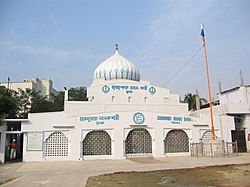Sikhism in Bangladesh
 | |
| Founder | |
|---|---|
| Guru Nanak | |
| Regions with significant populations | |
| Dhaka Chittagong Mymensingh | |
| Scriptures | |
| Guru Granth Sahib | |
| Languages | |
| Sant Bhasha (sacred) Punjabi (cultural) Bengali (national) Urdu |
| Part of a series on |
| Sikhism |
|---|
 |
Sikhism in
History
Sikhism first emerged in
Nanak then sailed into
Guru Tegh Bahadur stayed in Dhaka between 1666 and 1668 after visiting Assam. During this time, Bulaki Das was the masand (Sikh minister) of Dhaka. He established the Gurdwara Sangat Tola (14 Sreesh Das Lane) in Bangla Bazar.[4] His wooden sandals are preserved at the Gurdwara Nanak Shahi.[6] He also visited the Gurdwara Sahib Sylhet twice. His successor, Guru Gobind Singh, issued many hukamnamas to the Sylhet temple and also visited Dhaka. The Gurdwara Sahib Sylhet provided war elephants for him too.[3][7]
By the early 18th century, there were a few Sikhs living in the region of Bengal.[8] One famous Sikh who lived during this time period was Omichand, a local Khatri Sikh banker and landlord who participate in the conspiracy against Nawab Siraj ud-Daulah with the East India Company.[8][9] The Flemish artist Frans Baltazard Solvyns arrived in Calcutta in 1791 and observed many Sikhs, whom one could differentiate from the rest of the land's inhabitants by their garbs and traditions.[8] He etched depictions of a Khalsa Sikh and a Nanakpanthi, which was published in 1799.[8]
Overtime, the Shujatpur sangat developed into what is now the Gurdwara Nanak Shahi from 1830 onwards. Under the initiative of Mahant Prem Daas, Bhai Nattha's well was reformed in 1833.[2] A large number of Sikhs found employment with the Assam Bengal Railway and a gurdwara was established for them in Pahartali, Chittagong.[10] The Gurdwara Sahib Sylhet was destroyed as result of the 1897 earthquake. The Sangat Sutrashashi at Urdu Road was later destroyed by the Sutra Sadhus. There is also a gurdwara in Banigram, Banshkhali.[11]
In 1945, Sikhs established the Gurdwara Guru Nanak Sahib in
Demographics
The Sikh population almost entirely consists of
Government recognition
The Government of Pakistan requisitioned this part of Jafarabad under Sikh supervision until 1959. A handwritten copy of the Guru Granth Sahib from the time of Guru Arjan was kept at the Gurdwara Sangat Tola and later moved to the Gurdwara Nanak Shahi in 1985.[12] After the independence of Bangladesh, Bhai Kartar Singh and the Bangladesh Gurdwara Management Board seized control of all the gurdwaras in the country including the central Gurdwara Nanak Shahi of Dhaka.[2]
References
- ^ "Prayers from Punjab". The Daily Star. Retrieved 2016-12-20.
- ^ OL 30677644M. Retrieved 24 April 2024.
- ^ OL 30677644M. Retrieved 24 April 2024.
- ^ Allahabad: The Pioneer Press. p. 70.
- OL 30677644M. Retrieved 24 April 2024.
- ^ OL 30677644M. Retrieved 24 April 2024.
- ISBN 9788126908585.
- ^ a b c d Hardgrave, R. L. (1996). An Early Portrayal of the Sikhs: Two 18th Century Etchings by Baltazard Solvyns. International Journal of Punjab Studies, 3(2), 213-27. Accessed via: https://www.laits.utexas.edu/solvyns-project/sikhs.html
- ISBN 978-94-024-0845-4.
- Calcutta: Government of Assam.
- OL 30677644M. Retrieved 24 April 2024.
- OL 30677644M. Retrieved 24 April 2024.
